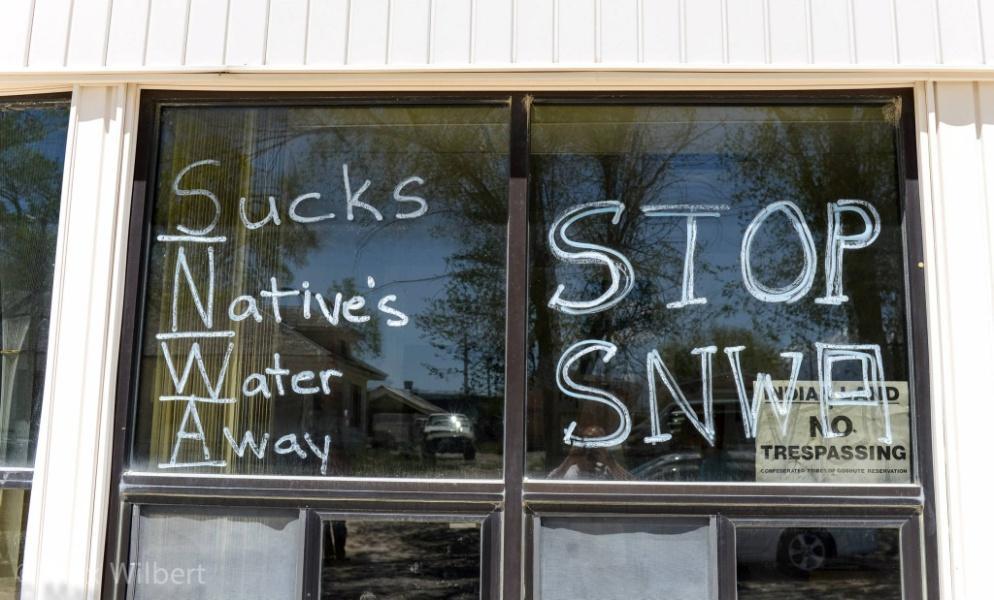After 31 years of resistance including contributions from Deep Green Resistance, Las Vegas has abandoned a water extraction project on indigenous lands in Nevada.
By Max Wilbert
On May 21st, after a series of legal defeats stretching over years, the Southern Nevada Water Authority (SNWA) began to withdraw its remaining federal and state applications to build a $10 billion water pipeline.
For three decades, SNWA (the water agency for the Las Vegas area) has worked towards building a 300-mile pipeline and dozens of wells to pump vast amounts of groundwater from Goshute, Paiute, and Shoshone indigenous land in eastern Nevada.
For thirty-one years, the community has fought this project, organizing public events, meetings, public comment, protests, lawsuits, hearings, and beyond. The Confederated Tribes of the Goshute Reservation, the Ely Shoshone, and the Duckwater Shoshone played a key role in this resistance, as have the Great Basin Water Network and local government efforts to oppose the project.
Deep Green Resistance began fighting the SNWA water grab in 2013, organizing a series of annual ecology and resistance gatherings in Spring Valley that continued through 2018, participating in lawsuits, elevating voices of the land, and supporting community organizers on the ground. We cannot and will not take credit for this victory, but we are happy today to see this news.
When I first visited the Confederated Tribes of the Goshute Reservation in 2013, the building bore a stark message: “SNWA: Sucks Native’s Water Away.” The tribe has stated that “SNWA’s groundwater development application is the biggest threat to the Goshute way of life since European settlers first arrived on Goshute lands more than 150 years ago.”

Life in the Great Basin’s valleys, human and otherwise, depends on shallow groundwater, springs, and creeks, which in turn depend on groundwater flows from rain and snow in mountain ranges. Water is life.
There is a place on the floor of the “Sacred Water Valley” or Bahsahwahbee, more commonly known as Spring Valley, where there grows an ecologically unique grove of Rocky Mountain Juniper Trees, where violets bloom and springs bubbling pure water from the Earth.
My friend Delaine Spilsbury, a board member of the Great Basin Water Network and Newe indigenous elder, writes:
“Bahsahwahbee is not just a piece of tribal history. It is American history and a harbinger of the future of indigenous communities. Military officials and vigilantes murdered Newe people there during three massacres between 1850 and 1900. Victims included women, children and elders whose bodies were viciously mutilated. Because it was such a violent event, the spirits of those desecrated are believed to remain in the shallow-rooted Rocky Mountain Juniper trees, referred to as Swamp Cedars. We Shoshone people still visit this location to show our respect for our Elders. To this day, Bahsahwahbee remains a place of mourning for my people.
My grandmother, Laurene Mamie Swallow, survived the Bahsahwahbee massacre of 1897. Oral histories that she and other tribal elders shared, along with documentation from military officials, have served as the historical basis for what we know about the site today.
Despite that information, it is important to note that Bahsahwahbee is more than a place in history. The Swamp Cedars would be lost forever if large-scale pumping were to occur at the site. And, therefore, the ability for indigenous people to practice their spiritual beliefs would be gone too.”
Today, the spirits in the Swamp Cedars can, perhaps, rest a bit easier. But only for now. There still remain countless threats to the Great Basin. Mining is devastating the region. The destruction of Pinyon-Juniper forests continues. Urban sprawl continues to metastasize into the desert, and countless species are on the brink of extinction. Nuclear waste continues to impact indigenous communities. As global warming melts snowpack in the Rocky Mountains and the Colorado River shrinks, cities like Las Vegas will continue to hunt for water—potentially leading to new water grab projects.
The pure springs of these valleys are not safe, and nor are the Swamp Cedars. While land protectors focus on climate change and the Amazon rainforest, countless other parts of our living planet face destruction without appreciation. We must protect all of this world, and that means challenging every water extraction project, every logging plan, every new mine, every factory—even to the fundamental pillars of industrial civilization itself.
For life on this planet to continue, industrial civilization must come to an end. So rejoice, because the water grab is dead. And then get back to the struggle.

Max Wilbert is a third-generation political dissident, writer, and wilderness guide. He has been involved in grassroots organizing for nearly 20 years. His essays have been published in Earth Island Journal, Counterpunch, DGR News Service, and elsewhere, and have been translated into at least 6 languages. His second book, Bright Green Lies: The False Promises of Mainstream Environmentalism , will be released soon. Photos by the author.
